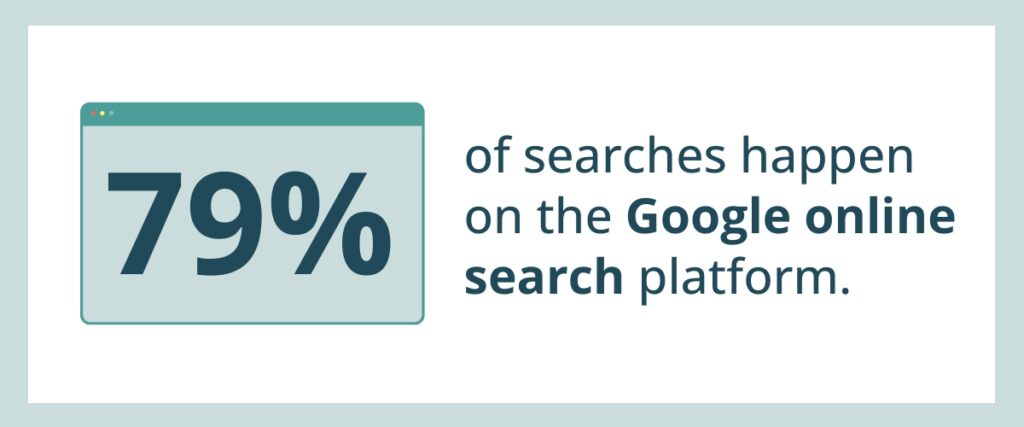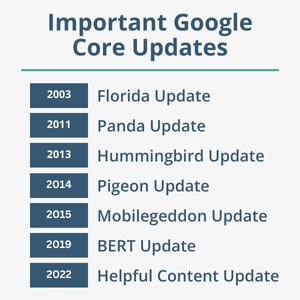Updated: April 2025
Algorithm updates, particularly those rolled out by Google, can greatly affect your digital marketing efforts, both positively and negatively. Every algorithm change is meant to improve a user’s search experience online, but what exactly are these updates and why do they happen?
What Are Algorithms?
Algorithms are systems that search engines use to retrieve web pages from their index to present to users when they perform a search. These systems take a number of SEO ranking factors into consideration and place search results in order of which pages it thinks will best answer the user’s search query.
All search engines, like Google, Bing, and Yahoo, have different algorithm updates that they make. But, we’re going to focus on Google, which dominates the online search market with 79% of searches happening on the platform.
Why Do Updates Happen?
Algorithm updates are changes in the way search engines rank web pages in results. These updates are continually worked on and released by Google to provide the best and most accurate results and experience for users. Updates help search engines:
- Understand human language
- Understand search intent
- Provide more accurate results
- Provide more search features
- Provide more localized results
- Judge the quality of content on a page
Types of Search Updates
Search algorithm updates can be broken down into two categories:
- Minor Updates are small updates that can happen and be unnoticeable or have little effect on your website and keyword KPIs.
- Core Updates are major updates that can impact your website and rankings overnight – for better or for worse.
Important Google Core Updates
Google updates often target specific practices to create a more level playing field. They can also impact specific platforms or industries to improve and specialize results for users.
While there have been a vast number of core updates, with more continually being worked on, here are a few important updates to know.
Florida Update, 2003
The Florida update was Google’s first major update released on November 16, 2003. It targeted spammy online tactics from the past decade that were used by many websites, primarily those in the online retail space. These tactics included keyword stuffing, having multiple sites for one brand, cloaked content (showing search engine crawlers different content than what a user sees), and hidden links.
Results:
- Websites that ranked for high-value commercial keywords had their rankings wiped out right before the holiday season.
- Many innocent websites also lost ranks as “false positives”.
Panda Update, 2011
The Panda update took many months to roll out in its entirety. It targeted thin content, content farms, and websites with poor user metrics. With the Panda update, Google really focused on being user-centric, wanting to provide users with the best results possible. This was the start of focusing on the quality of content over the quantity of content.
Results:
- Sites with original, high-quality, valuable content are favored in search results.
Hummingbird Update, 2013
With Hummingbird, algorithms were updated to begin to understand the relationship and placement of words. This helped Google search understand queries and intent better, offering users more relevant search results.
Results:
- Introduction of natural language processing.
- Made Google’s algorithm more precise and fast.
Pigeon Update, 2014
Pigeon was created to offer better local search results for users by suggesting businesses close to where they performed a search. Additionally, Pigeon helped brick-and-mortar stores, regardless of their size and brand popularity, be more competitive with larger companies in local search results.
Results:
- Ranking signals for local search and Google Maps updated.
- Location and distance ranking parameters are improved to account for where a user makes a search.
Mobilegeddon Update, 2015
The Mobilegeddon update of 2015 was Google’s answer to the increasing rate of users searching on mobile devices. This was the start of Google starting to consider a site’s mobile-friendliness.
Results:
- Mobile-friendly websites rank higher.
- Websites are penalized if they:
- Use a lot of flash
- Have a lot of small text
- Have clickable elements that are close together
- Don’t adapt to different screen sizes
BERT Update, 2019
The BERT update was a building block of Hummingbird that continued to help Google understand search queries and content. BERT helps search engines read content like users do and looks at the context of a word to better understand what it means.
Results:
- Search queries are better understood.
- Rewards content that is well-written and formatted with users in mind rather than search engines.
Helpful Content Update, 2022
Google’s Helpful Content update in 2022 focused on targeting content that seems to be written for ranking in search results instead of helping end users. The update rewarded well-written, informative content for people, rather than search engines.
Results:
- “People-first” content rewarded.
- Low-quality, unoriginal content downgraded.
Stay Up-to-Date With Algorithm Updates
Staying on top of new rollouts and updates and making changes to your marketing plans can be time-consuming. Fortunately, Google is pretty good at keeping us updated with rollouts in their Search Central Blog. Partnering with a digital marketing agency like Mad Fish that makes SEO and content strategies with algorithm updates in mind is also a great idea if we do say so ourselves.
Learn more about this article’s author, Content Strategist, Marcus Yoo.
Want to chat? Contact us with questions about our content and other digital marketing services. We’re ready when you are!



